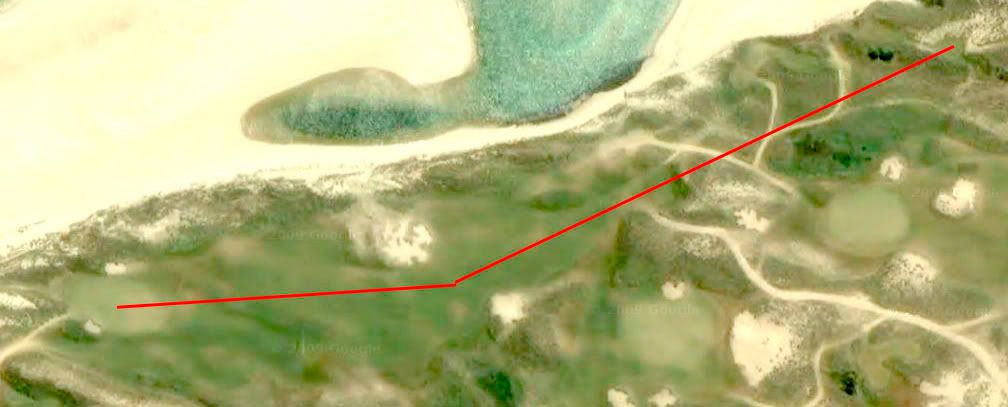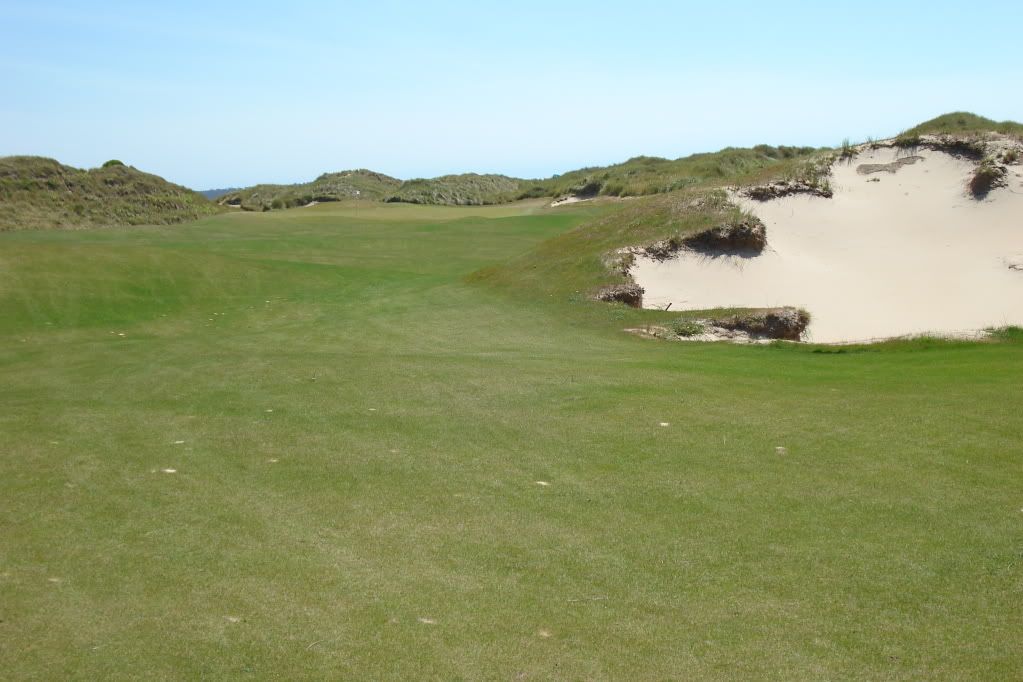Hole #17 Par 4 400 meters (440 yards)Standing on the tee at the 17, buffeted by the wind, distracted by the beautiful views of dunes and sea, you are quickly given a slap upside your golfing head as you contemplate how to play this hole.
I must say that after 16 holes of playing the back tees that I never felt that I was in over my head length-wise (although at almost 6,800 yards on a par of 71, I should be out of my comfort zone). This hole took me out of my depth. At 440 yards into a three club wind it got me wondering why I was walking back 70 yards to get up the dune to the tips. From one set of tees up it is much more manageable at 326 meters (359 yards).

The following is based on playing the hole into the prevailing brisk breeze. I understand that it would be quite a different hole in calm conditions or with a following breeze. Upwind from the back tee, this hole is a real examination of your golf game. I tried the exam, and failed.
This hole, stands out as perhaps the only hole on the course where there is no safe play off the tee. The challenge/risk isn't left to the second shot. It is staring you in the face on the tee. From the aerial (and not at all visible from the tee) there are essentially two landing areas, one short of the bunkers and another past the bunkers, joined by a 30 yard wide neck of fairway.
From the back tee, it is about 200 yards to reach the fairway and 270 yards to reach the neck of the fairway. In the short landing area the fairway is about 25 yards, widening out to about 45 yards just short of the bunkers. The second landing area past the bunkers is a generous 75 yards wide.
In breezy conditions I don't believe even the long hitters could fly the bunkers. For the vast majority of short to medium hitters the problem is getting to the wider part of the first landing area. With dunes of waving marram grass and the breeze in your face, this is a daunting tee shot. Claustrophobic compared to what has come before.
From the 16 tee, the following picture shows a high level view of the 17th. The 17th tee is about 50 yards down and to the right of this vantage point. From the 17th tee the view is of waving marram grass and what looks to be an impossibly small landing area.

To set up the second shot the left side of the landing area provides a more open shot, while the right side is blinded by the bunker, albeit providing a shorter shot. The second can be anywhere from a daunting 175 yards to an impossible 215 yards into the wind.
The fairway short of the green is defined by a ridge that runs from far right to short left and plays havoc with second shots that come up short. There are no level lies to be had short, where a lot of shots knocked down by the wind will end up.

The complexity and problem of the green are not really revealed from where the second shots are hit. The green is perched up about 4 feet from the fairway and surrounds, and is on a peninsula that extends out of the surrounding dunes at the rear of the green. Any ball that doesn't land on the green is likely to be rejected by the embankment around the green.
Recovery from the closely mown surrounds will require a delicate and creative shot, especially to front pins. It will likely be impossible to get a recovery from left of the green close to any left pin position as the green runs back and right.

The green itself, provides lots of internal movement to add insult to injury at the end of a difficult hole.
For me, this was the most difficult hole on the course, deserving of being the third stroke hole. Under the prevailing winds I think it is much harder than the first stroke hole - #8, and arguably harder than the second stroke hole - #18. As your round draws to a close, your score is likely to be defined by your ability to survive 17 and 18 on the scorecard.